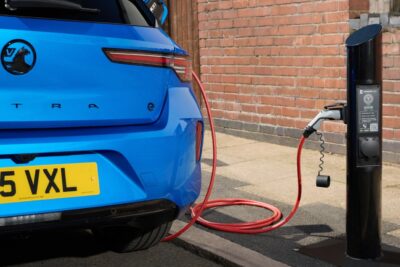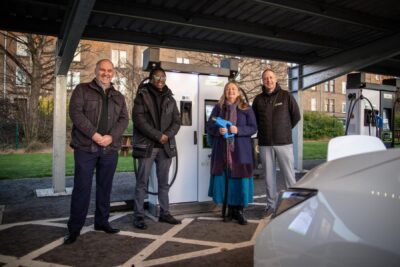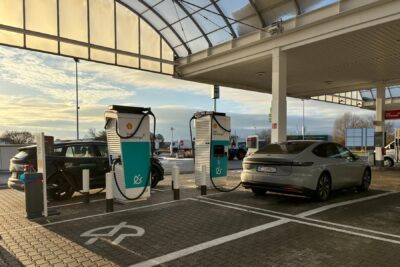
From coffee to kilowatt – Nayax eyes dominant market share in EV charging payments
Nayax has leveraged its pedigree in unattended payments to establish itself as a leading provider of payment solutions for EV chargers globally. Carlos López Montero, VP of Business Development at Nayax, explains that the company’s background in processing card payments translates directly into EV charging, where ease of use and reliability remain critical.
While the early focus in EV charging was on app-based payments and closed-loop solutions, Nayax sees strong demand for open-loop systems such as contactless bank card payments, Apple Pay, and Google Pay, particularly in environments with transient users like hotels, shopping centres, and public car parks.
Today, the Israeli company provides its payment terminals to around 50 charger manufacturers globally, including ABB, Alpitronic, Autel, Vestel, BTC Power, SK Signet, and Delta.
In the interview at the EVS38 in Gothenburg in June, López Montero spoke to us about the state of the industry, data security, and the challenges ahead.
Mr. López Montero, Nayax has a strong background in cashless payments – coffee machines, vending machines, that world. How has this experience shaped your approach to EV charging stations?
At the end of the day, our main competitor has always been cash. In EV charging, cash was never an option, but our expertise in processing cashless payments – especially credit card payments – translates directly. When EV charging started, it was just about reading a card at the charger, processing the transaction with the bank, and that was it. Now, we receive transactions over standard protocols like OCPI from the management systems. Payments remain the basics, of course, but you need to adapt to the vendors and the ecosystem. EV charging has a strong ecosystem, and you can’t operate outside of it.
When you approached the market, were most operators open to your solution? Or did many say, “No thanks, we’ll handle it with QR codes or our own app”?
It’s funny – everyone talks about regulation, but I always say, you’re running a business. You should care about making it easy for customers to pay. I’ve never seen a business succeed by making payment difficult. We’re not competing with apps – we’re just another payment option that might suit certain customers better. It expands your potential user base. Imagine I’m a tourist in Norway and need to download an app, get an SMS confirmation, but my phone service isn’t working. Do you want me to pay, or do you want me to walk away? Obviously, you want me to pay. Apple Pay works everywhere – Singapore, the US, South Africa – so why shouldn’t I be able to pay with it at an EV charger? It just makes sense.
So did we face resistance? Not really. Operators know card payments are one of the preferred options. They approach it either because of regulation or because they want to offer a better customer experience.
This industry has many segments. Utilities or petrol station networks might build loyalty programmes, so apps are valid for them. But if you’re a hotel, a shopping centre, a golf course, or a private parking garage, there’s no user engagement. People might not come back, so why force them to download an app? These are ad-hoc, anonymous users who just want to charge. Maintaining an app for that is too much work. Just install a payment terminal and let them pay.
Let’s talk numbers. How many CPOs use your solution, and which ones?
We’re currently selling terminals to around 50 EV charger manufacturers. These are, for example, ABB, Vestel, Alpitronic, Autel, BTC Power in the US – one of our biggest customers – SK Signet, Delta… really, all the top manufacturers.
What’s your approach to growing further? Is there a limit?
The approach is simple: offer better solutions than competitors. There are a few main players: Payter, CCV, Nayax itself, and Ingenico. Each has a different go-to-market strategy and portfolio. Some focus on selling payment terminals alone, while Nayax is an end-to-end solutions provider.
When a CPO works with us, they’re onboarded as a merchant within Nayax. We handle payouts, merchant services, KYC, due diligence, refunds, and negotiate commissions directly. Others sell the terminal and ask the CPO to arrange merchant accounts with banks themselves. So, payments-wise and service-wise, we are not all the same.
What makes you stand out technologically?
Maybe what makes us stand out technologically. We’ve shifted to open standards like OCPI, leaving behind private APIs that consumed too many resources. For small CPOs, we can manage chargers from our server and handle billing functions, offering an all-in-one solution. This lowers barriers to entry because the process of sourcing chargers, platforms, payment solutions, and integrating them all is too complex and expensive for newcomers. We offer a simpler, cheaper way.
How does your solution support closed-loop versus open-loop environments?
Nayax has always gone beyond open-loop payments. We integrate alternative payment methods – PayPal, Alipay – and local wallets in each country. In Europe, for example, we’ve integrated DKV fuel cards, the most widely used here. In the US, we’re integrating WEX fuel cards so people can pay at EV chargers just like they pay at petrol stations. It’s a compelling pitch.
You mentioned loyalty programmes. What about real-time data and consumer analytics?
We developed what we call the digital receipt platform. When customers authorise a transaction on our terminal, they see a QR code. Scanning it shows real-time charging details – battery percentage on DC chargers, session time, kWh delivered, and cost. They can register their email to receive a receipt. This email can be shared with CPOs to link transactions to loyalty programmes. It also enables marketing automation, connecting offline visits with online campaigns. Some CPOs worry that payment terminals mean no user engagement, but through email, you can build meaningful interactions.
What about failed transactions? It happens with cards or apps – suddenly you can’t charge. How do you handle that, especially with 50 OEMs involved?
Failed transactions happen for many reasons. For example, if the acquirer says there’s insufficient balance, we can ask the customer to present another card or use Apple Pay or Google Pay, which are authenticated transactions. Another approach is incremental authorisation. Instead of preauthorising the maximum possible charge session – say €75 – which can cause declines, we start with a lower amount, like €20 or €30, and increment it during the session. If authorisation fails at any point, we stop charging. These mechanisms reduce failed payments significantly.
Looking ahead a year or two, what do you see as the biggest challenges?
The industry is currently on shaky ground – it’s not delivering the growth many expected. There’s strong competition, especially for manufacturers and management systems. But Nayax is a big, publicly listed company. We’re here for the long run. Eventually, we know we will have a dominant market position – in customer base, technology, and geographical presence. We’re not here for short-term wins.
What are you doing actively to overcome these challenges?
We focus on helping CPOs become profitable because, without profitability, no one invests in infrastructure. One way is to adapt our business model. Instead of fixed monthly fees, we’re piloting transaction-based fees. If they have no transactions, they don’t pay. If they have transactions, they pay a few cents per use, turning fixed costs into variable costs.
We also offer financing. Nayax Capital can purchase chargers and installations on their behalf, turning CAPEX into OPEX. They pay us back via rental models or transaction fees. We’re not a bank – we’re not charging interest – we just want more payment terminals deployed. Helping merchants is in our DNA.
Mr. López Montero, thank you for taking the time to talk to us.





0 Comments